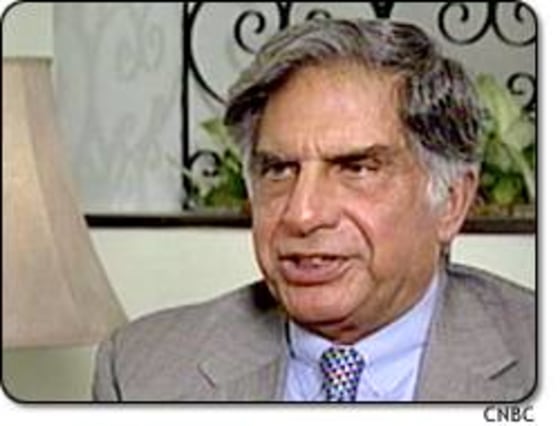India — the second most populous country in the world — is crowded with business moguls, and none are bigger than Ratan Tata. His name, Tata, literally means big business in India.
In a nation of more than one billion people, there may be no single person with greater economic and political clout than Ratan Tata.
Tata, a normally media-shy man, heads a family conglomerate that touches almost every commercial sector in India. Even in American industrial history, there is no parallel.
Take a look almost anywhere in India, and you will see the name of this 65-year old Cornell University graduate, who inherited control of an industrial empire dating back to the early days of the British Raj. Tata’s influence spans from transportation, to steel to power lines to telecom.
Years ago, Tata recognized the business world was changing and steered the empire away from commodity goods like textiles.
“My main contribution, if you like, is to move us into the high tech areas of business, partly in IT, partly in telecommuncations, partly in process control,” Tata says.
Today, the Tata Group has about 85 operating companies, many publicly traded, with combined revenues of $11.2 billion. That’s 2.4 percent of India’s gross domestic product.
You can hardly cross a street in India without seeing a Tata truck, bus or SUV.
Dig beneath the surface and you will see Tata’s presence in hotels, insurance, mutual funds, even management consulting.
Ask Ratan Tata about himself and he is surprisingly modest, but ask him about India, and his vision is more vast than his empire.
“As I’ve grown older, I’ve felt one really has to do something for the many underprivileged people in India and it is the responsibility of people like us to do so, not merely to become richer or more prosperous.”
Tata’s influence has only grown as India has ascended as a major player on the world economic stage.
As Indian markets have opened over the past decade, even the mighty Tata Group has had to adjust to global competition.
“We woke up one day and realized we had almost 300 companies, or 80 companies that were major companies ... so, there were many decisions that had to be communicated to a whole host of different entities,” Tata said.
Painful decisions that included downsizing some businesses, and shuttering others.
Still, he placed some big business bets while the world economy sputtered in the early 1990s.
By the end of the decade, Tata had introduced the Indica ... India’s first independently designed and built automobile. Shrewdly conceived on the eve of the Indian auto market boom, the Indica now has more than a quarter million sales to its credit.
“I saw tremendous potential for growth in the car business,” Tata said, “and a bit of national pride that maybe we could build our own car, and everyone said, no you can’t.”
Did that make Tata more competitive? “Yes it did. [I’m] sort of a stubborn person, I need a challenge.”
India provides plenty of those .
“In my spare time I don’t just think about new businesses for the group, I am just as much involved in trying to think ... would there be a way to convert the desert into a crop field or would there be a way to increase the water supply [in] India, and those, or new kinds of alternate medicine that might wipe out some of the epidemics we have.”
And Tata has even bigger economic dreams for his country.
“I ask myself quite often what would happen if India and China could themselves create an economic bloc of their own with two billion people,” Tata said, adding, “China being the factory of the world and India perhaps being the IT or high-end services of the world. Could [we] together do something that would be formidable?” It’s something, Tata says, is worth thinking about.
